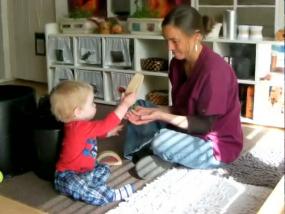Seeing Early Logic in Object Play

Truman places objects in Abby's hands. Shall we treat this encounter as a sweet moment of fun, or consider the regularity of Truman's actions as a foundation for logic. Let’s see what yields when we describe his action as rules, similar to the "if - then" logic of computer programming or any well stated set of instructions (see J. Langer, 1982).
Truman’s first rule begins with two empty hands and a ball. The rule states: If a hand is empty, fill it with a ball. Since each hand becomes empty when the ball is moved to the other, Truman goes back and forth between the two hands. 00:00 to 00:42. Note, toward the end of this segment, that Truman holds the ball in the middle, as if he realizes he needs to get out of this endless back and forth.
In the next segment (00:42 - 01:05), Truman tries to find places for three objects in two hands. Two of the objects are similar (semi-circle blocks). For a moment it looks as though his new rule is: Place similar objects, one in each hand. But the presence of the ball confuses him. Where should the ball go? Should it be placed in an empty hand? No. On top of the semi-circle he placed earlier in Abby's left hand? No. To establish the equivalence of the two similar semi-circles, he gives up on placing them in Abby's hands and taps them together at the mid-line. This bilateral banging action could well be the foundation of the concept of separate-but-equal (see G. Forman, 1982).
Now (01:06 to 01:50) we have the first rule applied again with the ball: If the hand is empty, fill it. This rule was initiated when the semi-circle got in the way of placing the ball in Abby’s left hand. He removes the semi-circle (we think so he can place the ball in her left hand), but once he places the ball in Abby's left hand he sees that her right hand is empty, so back and forth he goes.
Truman realizes he is in another endless loop, but this time he merges the right into the left in a new way. He claps his hands together (something Abby showed him some moves back). His actions almost say, "I can't put the ball in two places at the same time, but I can represent the merging of the two sides by clapping my hands together." Children, the world over, treat clapping as an appealing action. Even so, this action becomes a tangible method to consolidate "separate-but together/together-but-apart," what logicians call "equivalence." To externalize this concept beyond his own hands, Truman holds Abby's hands and moves them together and apart (01:50, and again at 03:01). His hands are no longer the content of equivalence, but rather are the author or agent of the expression of this concept. By moving other objects, action patterns of the hands become more general and more useful in helping children organize, structure, and create rules that are a type of early math.
Now watch the remaining two and a half minutes to see if you can figure out the rules Truman uses as he plays with Abby. Look for repeated actions with two or more steps. Look for aborted actions (change of mind). Look for the onset of sound as a marker for an action sequence or an expression of equivalence. Also appreciate how responsive Abby is to Truman's intentions. Notice how responsive she is to Truman's cue to make her open hands available (00:22) and how steady she holds her open hands, patiently smiling at Truman to signal her willingness to play according to his rules. This is an excellent example of an adult and child in perfect synchrony and a profound example of the development of the early logic of empty sets, full sets, and equivalent sets.
References Jonas Langer, 1980. The Origins of Logic: Six to Twelve Months, New York: Academic Press George Forman (Ed.), 1982. Action and Thought, From Sensorimotor Schemes to Symbolic Operations, New York: Academic Press.
